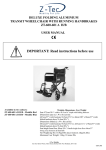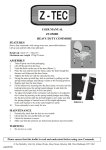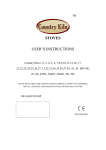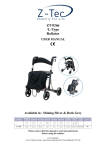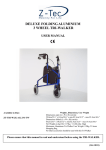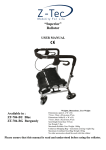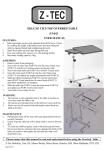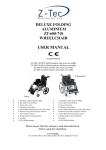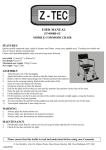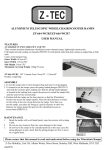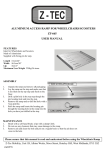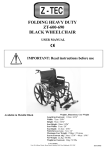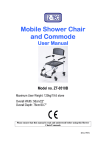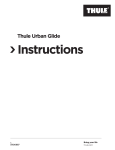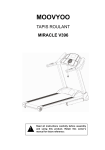Download ZT-600-601A August 2010
Transcript
Mobility For Life DELUXE FOLDING ALUMINIUM TRANSIT WHEELCHAIR ZT-600-601A USER MANUAL IMPORTANT: Read instructions before use Available in two colours: ZT-600-601A R - Metallic Red ZT-600-601A B - Metallic Blue Weights, Dimensions, User Weight Seat 47.5cm/18¾” width x 40.7cm/16” depth with folding backrest. Dimensions open (L x W x H) (cm/in): 68.5cm/27” (with footrests 94.5cm/37¼”) x 61cm/24” x 94cm/37” (with folded backrest down 76.5cm/30¼”) Dimensions folded (L x W x H) (cm/in): 68.5cm/27” (with footrests 94.5cm/37¼”) x 28.5cm/11¼” x 94cm/37” (with folded backrest down 76.5cm/30¼”) Seat height from floor 50cm/19¾”, Handle height from floor 94cm/37” Swing away footrests & Seat belt Net Weight (kg/1b): 10.3kg/22.5lbs (incl. footrests 11.5kg/25.2lbs) Maximum User Weight: 116kg /18 stone 2lbs Z-Tec Mobility Unit 1B, Albion Works, Moor Street, Brierley Hill, West Midlands, DY5 3SZ (Aug 10) Contents 1. 2. 3. 4. 5. 6. Introduction Indications For Use Contraindications Cautions Parts Description Assembling The Wheelchair 7. Brake Operation & Brake Maintenance 8. Transportation 9. Warnings 10. Warranty 11. Weights/Dimensions (front page) 1. Introduction The ZT-600-601A is a high quality transit wheelchair in lightweight aluminium, side skirts, lap belt and is available in two metallic colours. The wheelchairs are suitable for everyday indoor & outdoor use. They are lightweight & portable. The wheelchairs are manufactured to the highest quality standards & are CE marked as Medical Devices. 2. Indications For Use This wheelchair is intended for the temporary transportation of a single occupant who has a walking disability. The wheelchair is intended to be propelled only by an attendant who is suitably able to control and manoeuvre the wheelchair and who has gained familiarity with the proper operation of the wheelchair, its brakes, motion and handling. 3. Contraindications This wheelchair is not intended to be self propelled. The wheelchair is not for use by occupants weighing more than 116 Kg (18 stone 2 lbs). This wheelchair is not intended for use in a motor vehicle. 4. Cautions The attendant who is to operate the wheelchair should familiarise themselves with the operation of the wheelchair and parking brakes both before and after an occupant is seated and the wheelchair is used. Note that the parking brakes are operated by hand. See section on brakes in this manual. The attendant should consider their own wellbeing before operating the wheelchair; they should understand their limitations and strength and not attempt anything that is beyond their capability so as to ensure the wheelchair occupant’s and their own safety. The attendant should ensure that the handles of the wheelchair are firmly held to control the wheelchair while it is in motion and while the parking brakes are not applied. Attendants should take particular care if gloves are worn as these may restrict their grip on the handles of the wheelchair. Avoid the occupant changing their centre of gravity by leaning or reaching to one side or the other from the wheelchair as this upper body movement of the occupant may cause the wheelchair to tip over. When ascending slopes with the wheelchair ensure that the occupant’s body is leant slightly forward. Do not carry extra weight such as bags, pets or third parties on the wheelchair as this will add excess weight and cause instability to the wheelchair. Whenever the wheelchair is brought to rest, this should be on level ground and both parking brakes should always be firmly engaged. Transfers of the occupant to and from the wheelchair should always take place on level ground in a safe environment. Pay particular attention when using the wheelchair in a public traffic area and never leave the occupant in the wheelchair unsupervised. It is advisable to plan your wheelchair route beforehand and take particular care in wet or icy weather or if traversing soft ground. Look out for kerbs and uneven surfaces. Obstacles should be avoided as hitting them may displace the occupant as well as cause damage to the wheelchair. PUSH HANDLE FOLDING BACK PARK BRAKE 5. Parts Description PADDED ARMREST SIDE SKIRT LAP BELT KERB LIFTER LEG REST 12” REAR WHEEL 8” FRONT CASTOR (Aug 10) 1. 2. 3. 4. 4. Assembling the Wheelchair Remove all packaging from the wheelchair. Fold out the wheelchair by standing at the front of the chair, put both hands onto the seat upholstery and push down until the seat is completely open. Lift up the folding back and click into position. To install footrests place left/right footrest over left/right pegs at a 900 angle to the frame, turn forward 900 to lock footrests (see photos 1 & 2 below). PHOTO 1 5. PHOTO 2 Legrest adjustment—for optimum comfort it is important to attain the correct leg position. The footrests have been designed so that they can be extended into a number of positions. Sit the user in the wheelchair whilst adjustment is carried out. Release the bolt at the base of the legrest, slide down until a comfortable length has been found for the user, then tighten up the bolt to secure position. A suggested comfortable position is when the upper leg is resting comfortably on the seat whilst the footrest is supporting the weight of the lower leg. Kerb lifter—use the kerb lifter to raise the front castors. Mounting a kerb: Approach the kerb head on, attendant to push down on the tube with a foot to raise front castors, lower front castors onto the raised kerb. Finally attendant to push wheelchair forward, lifting it up slightly to mount kerb with rear wheels. Down a kerb: Line up the front castors with the edge of the kerb. The attendant uses the kerb lifter to raise the front castors, tip the occupant slightly back. Keeping the castors raised, slowly lower the wheelchair down the kerb. Do not raise the front castors by pushing down on the push handles as this could result in damage to the wheelchair. Lap Belt– to be used to restrain the wheelchair occupant during normal daily use. Belt must be worn low across the front of the pelvis. Belt restraints must be adjusted as tightly as possible consistent with user comfort and should be straight not twisted. Belt restraints must not be held away from the body by any wheelchair components such as armrests. 6. 7. IMPORTANT: Under no circumstances should this wheelchair be used as a seat in a motor vehicle. The wheelchair occupant should transfer to a normal vehicle seat & the wheelchair should be stored safely away. This wheelchair has not been designed to be used as a seat in a motor vehicle, and failure to follow the above instructions could result in injury. PHOTO 3 5. Brake Operation & Brake Maintenance PARKING BRAKES– TO BE OPERATED BY HAND ONLY. 1. To apply the parking brakes, pull the black handle up by hand towards the back of the wheelchair (A as in photo 3). 2. To release the parking brake, push the black handle down by hand towards the front of the wheelchair (B as in photo 4). B NOTE: Always use the parking brakes when the wheelchair/ occupant are in a stationary position. Always park the wheelchair on level ground. (Aug 10) A PHOTO 4 MAINTENANCE The parking brakes are factory preset, they should only need adjusting due to wear and tear. 1. To adjust the whole of the brake unit, slacken off the two allen key bolts (C in photo 5) and slide the unit downwards until the parking brake arm is 2cm—2.5cm away from the wheel (D in photo 6). Then tighten up the two allen key bolts. PHOTO 5 PHOTO 6 2cm-2.5cm C D 8. Transportation 1. 2. 3. To fold the wheelchair, ensure that the footrests are in the forward position and that the plastic footplates are flipped up or completely remove footrests by pressing the footrest release lever & swing 900 outwards and lift off (photo 7). Stand to the side of the wheelchair take the front & back centre of the seat upholstery in each hand and pull the seat in an upward motion. The wheelchair will naturally fold up. PHOTO 7 Fold the backrest by “gently” pressing the levers forward, fold arms & backrest down. This mechanism enables the wheelchair to fit into small spaces such as the boot of a car (photo 8). 9. Warnings Do not stand on or put pressure on the footrests when entering or exiting the wheelchair. PHOTO 8 Should any defects become apparent on your wheelchair or if the brakes do not respond as well as expected cease using the wheelchair immediately and return it to your Z-Tec Mobility dealer for inspection. Check the tightness of screw and bolt connections monthly, if any connection becomes loose, stop using the wheelchair and consult your Z-Tec Mobility dealer for assistance. Check the moving parts (e.g. wheels, legrests & folding back) before every use. Check that the front castor wheels swivel freely. Withdraw from use if they do not work. Use caution near inflammables or fire and especially when holding lit cigarettes. Care should be taken when assembling and disassembling the wheelchair. This wheelchair weighs 10.5 Kg (23lbs) and care should be taken when lifting and moving it. If it should become necessary to clean the wheelchair then a soft cloth and mild detergent may be used. It is recommended that you have your wheelchair serviced every 12 months or more frequently if it is in regular use. If the upholstery becomes worn or damaged, replace it immediately. Do not carry out unauthorized modifications to the wheelchair always consult your authorized dealer. Only use approved accessories as specified by Z-Tec mobility. Also available for the ZT-600-601A are: Elevating legrests, Oxygen bottle bracket holders, IV poles & Wheelchair cushions 10. Warranty Z-Tec wheelchairs are guaranteed for 12 months from the date of purchase, this warranty is not transferable. Should any part of the wheelchair require repair or full or part replacement, as a result of a manufacturing or material defect within the warranty period, parts will be supplied free of charge. The guarantee excludes tyres & all items that have been subjected to undue wear & misuse. Under normal circumstances, no responsibility will be accepted where the wheelchair has not been maintained in accordance with the manufactures recommendations. This does not affect your statuary rights. If any other issues arise that are not mentioned in this user manual please write to the address on the front of this manual. Disposal—Contact your local authority to dispose of the wheelchair when no longer required. Z-Tec Mobility Unit 1B, Albion Works, Moor Street, Brierley Hill, West Midlands, DY5 3SZ (Aug 10)




